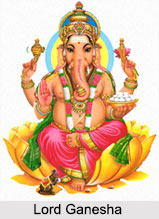 Ganesh Aarti is a final invocation of Lord Ganesha who is denoted as the elephant headed God who is praised as the almighty and fulfils all the desires of his followers. The most popular Ganesh Aarti is employed in to the north India remaining. Ganesh Aarti and chants from Rig Veda, a number of Upanishads and Puranas are sung with honest devotion in all over India. Ganesh Aarti is performed during Ganesh Chaturthi, which comes between August and September. The festival usually lasts for 10 days, ending on "Anant Chaturdashi" (fourteenth day of the waxing moon period).
Ganesh Aarti is a final invocation of Lord Ganesha who is denoted as the elephant headed God who is praised as the almighty and fulfils all the desires of his followers. The most popular Ganesh Aarti is employed in to the north India remaining. Ganesh Aarti and chants from Rig Veda, a number of Upanishads and Puranas are sung with honest devotion in all over India. Ganesh Aarti is performed during Ganesh Chaturthi, which comes between August and September. The festival usually lasts for 10 days, ending on "Anant Chaturdashi" (fourteenth day of the waxing moon period).
Legends of Ganesh Aarti
Lord Ganesha, who is the elephant headed God, is a very ancient deity who is worshipped by the Hindus. Ganesha is the son of Lord Shiva and Goddess Parvati and is also known as "Ganapathi", "Vinayaka" and "Vigneswara". He is the God who helps his follower to overcome all the obstacles in life and get the desired `Moksh`. He also protects homes and cars. Ganesha is also associated with learning and study. Lord Ganesha is worshipped as the first deity before the beginning of any religious ceremony. Every project is started with adoring this God. Worshipping Lord Ganesha endows the man with courage and confidence needed for any endeavour.
The priest with the chanting of Ganesh Aarti invokes the presence of Lord Ganesha using the statue as a channel, or body for his energy. This ritual is called as the "Pranapratishhtha". After this, the ritual called "Shhodashopachara" (16 ways of paying tribute) follows, with the coconut, jaggery, modaks, durva (trefoil) blades of grass and red flowers. The statue is anointed with red unguent, typically made of "kumkum" and sandalwood paste.
Hymns of Ganesh Aarti
Lord Ganesha is worshipped by the aarti-
Jai Ganesh Jai Ganesh, Jai Ganesh deva
Mata jaki Parvati, Pita Mahadeva.
Ek dant dayavant, char bhuja dhari
Mathe sindur sohai, muse ki savari,
Jai Ganesh...
Andhan ko ankh det, kodhin ko kaya
Banjhan ko putra det, nirdhan ko maya,
Jai Ganesh...
Pan chadhe, phul chadhe, aur chadhe meva
Ladduan ka bhog lage, saht kare seva,
Jai Ganesh...
Jai Ganesh, Jai Ganesh, Jai Ganesh deva,
Mata jaki Parvati, Pita Mahadeva
The aarti can be translated as- The devotee perform salutations to Lord Ganesha who is the son of great Lord Shiva and Parvati, who is daughter of the mountain king Himalaya. He is the Lord of compassion, who has single tusk, four arms and a bright mark of vermilion on the forehead. The mouse serves for his conveyance. People offer him betel leaves, blossoms, dry fruits and "laddus". Famous Ganpati Aarti sung in central India is:
"Om gan ganapateye namo namah
Shri siddhi vinaayak namo namah,
Ast vinaayak namo namah,
Ganpati bappa moray..."
Significance of Ganesh Aarti
Lord Ganesha is one of the most sacred and loved Hindu Gods. Each new puja is started by first worshipping and offering worships to Lord Ganesha. He is invoked and called to preside over any worship. Lord Ganesha is also the first to be worshipped in any fortunate event. Blessings of Lord Ganesha are believed to be the most powerful ones.




















